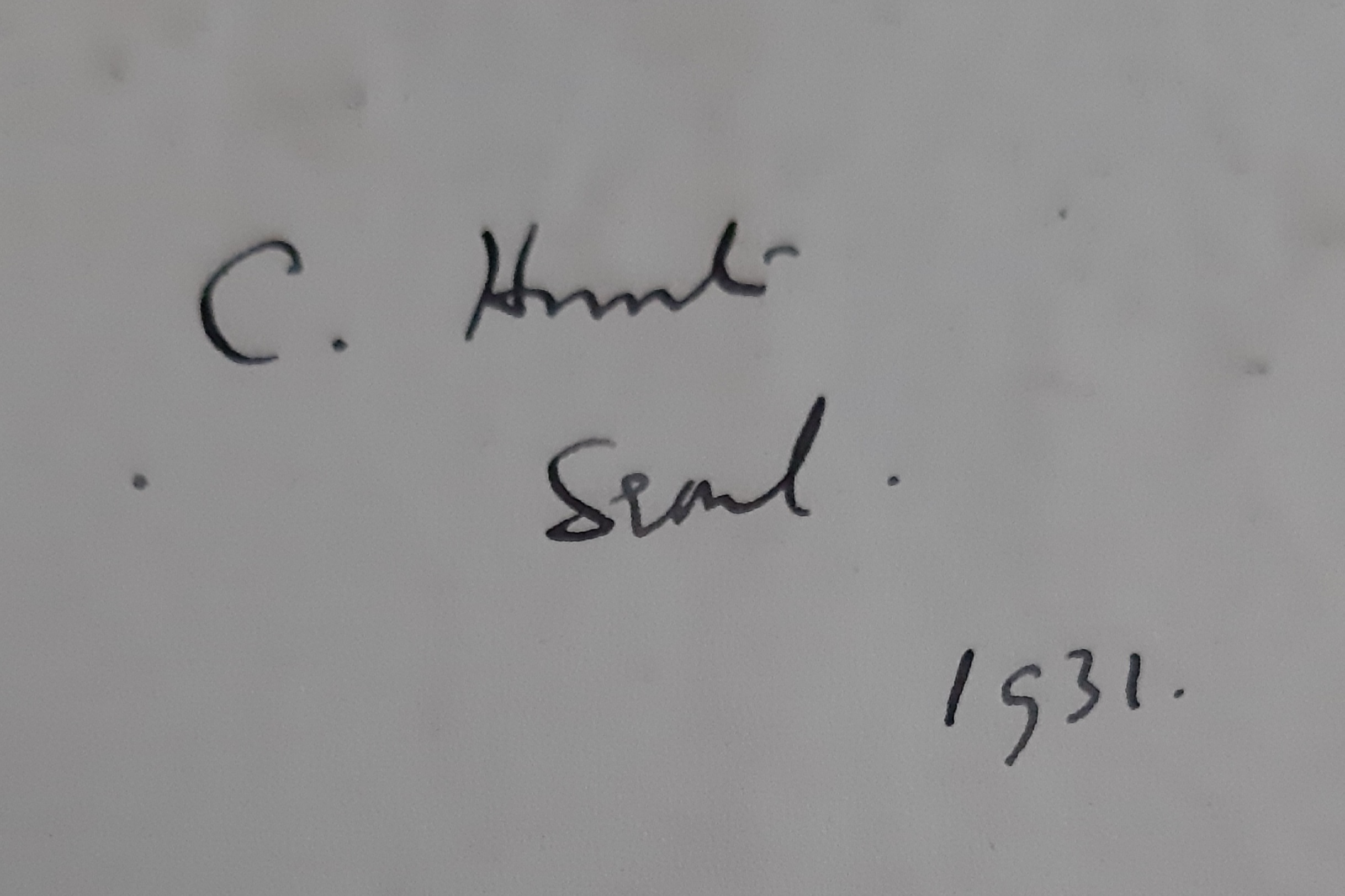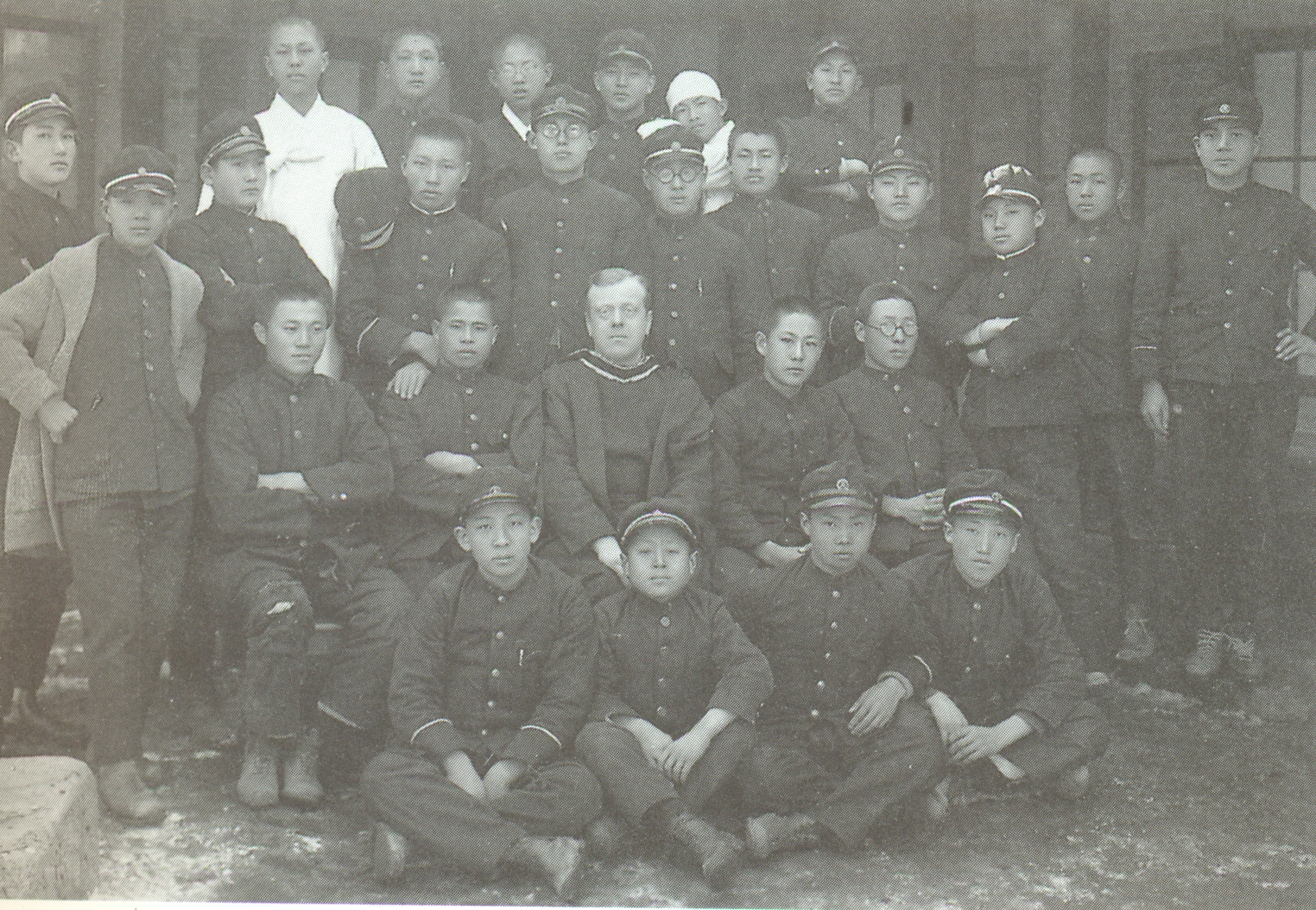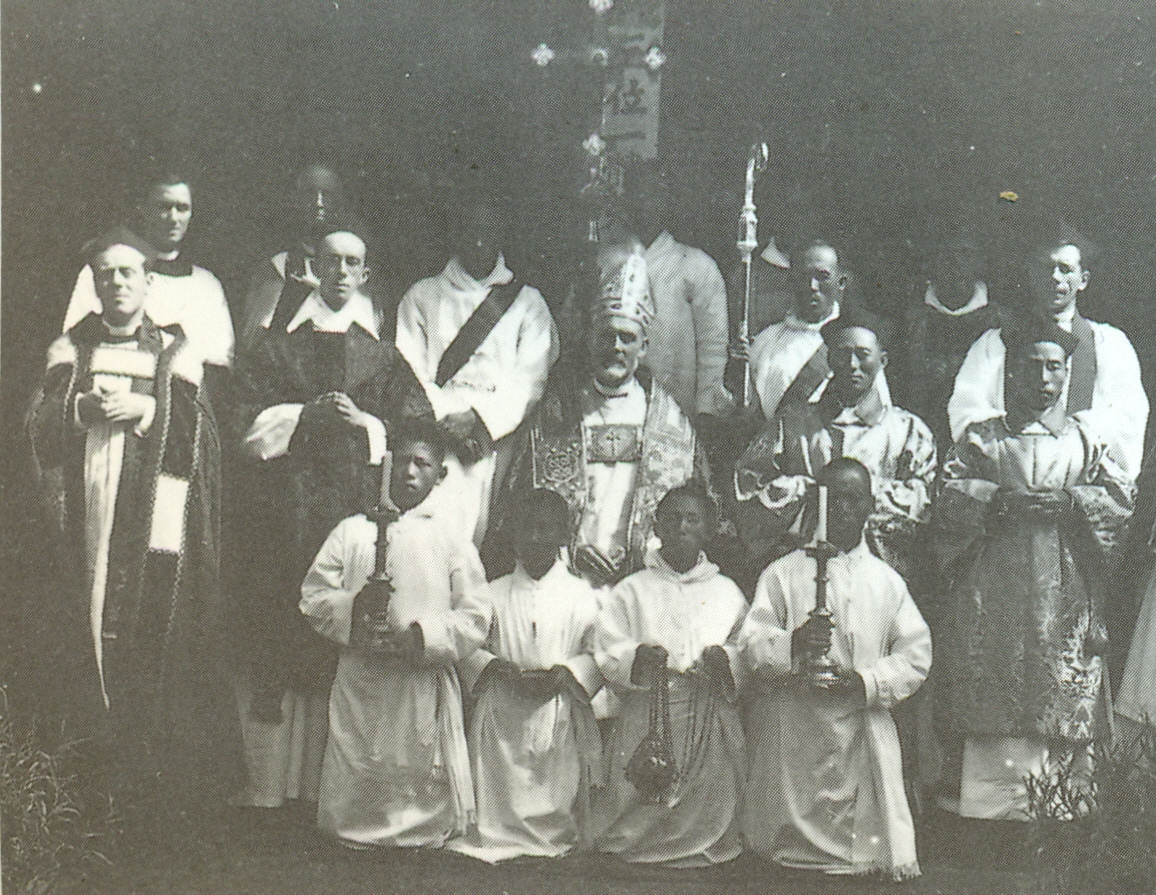Father Charles Hunt: Missionary and Martyr


John Tuck
Hunt was born in Wootton Bassett, Wiltshire in 1858,
the son of William Hunt and Maria (Tuck) who had
married in 1847. John Tuck Hunt had married Clara
Elizabeth Hobbs (1859-1914) at Bedminster in 1885 and
they had 3 children, John, William and Charles before
John Tuck Hunt died in 1890, aged only 32. At the 1891
Census Clara Elizabeth, a widow, was living at 16
Ashley Street, Bristol, with the 3 children and her
mother Elizabeth Shepstone (aged 75, she had married
Clara's (divorced?) father John Hobbs (1814-1884) at
Bedminster in 1867, some years after Clara's birth).
At the 1901 Census Clara and Charles were living there
alone while John and William were
boarding at the school known as Queen Elizabeth's
Hospital. Educated at Newfoundland Road Board School,
Bristol, Charles was employed for a time as a
solicitor's clerk; and apprenticed to an upholsterer
in Bristol; he then spent a year in the Society of the
Evangelist brotherhood, Wolverhampton; and a year at
Canning Town's St Cedd Church before studying for the
Anglican priesthood at St Augustine's College
1911-1915, the
(former) missionary college of the Anglican Communion
in Canterbury. He left for Korea as an S.P.G.
missionary before ordination, having earned a Licence
in Theology from the University of Durham by his
studies at Canterbury. He maintained a contact with
St. Augustines, writing them a total of 38 letters
throughout his life. At the 1911 Census, his 2
brothers were still living in Ashley Street with their
mother, John (24) is a "theological student" while
William is a commercial traveller. Their later lives
are not recorded.
Arriving in
Korea in 1915 together with Ernest Henry Arnold
(1890-1950 for a biography see at the foot
of this page), he went to live in Ganghwa Island
to learn Korean. In 1916 Hunt was ordained deacon
together with Arnold and served in the church in
Jincheon, North Chungcheong Province until their
ordination as priests in 1917, after which he served
at the Cathedral in Seoul, living at least for a time
with Bishop Trollope (1862-1930) and Fr.
Henry John Drake SSM, (who served in Korea
1898-1941) in the Bishop’s Lodge beside the Anglican
Cathedral in Seoul. None of them was married and
together they constituted a kind of miniature
monastery.
In 1920, Bishop
Trollope and Father Hunt travelled together to
England, the Bishop to attend the Lambeth Conference,
while Father Hunt gave a number of talks in various
parishes. They arrived in England, having crossed
North America by train, on June 15, and Fr. Hunt wrote
(in a letter to children in an issue of Morning
Calm): “at St. Bartholomew's, Herne Bay, a
little girl ran up to me and said: “Please, Father,
here is sixpence for you; I was going to buy a
photograph in a shop, but I want to give it to you for
Corea.” I was much touched by her self-sacrifice.
About a month ago I was at Rosliston, in Derbyshire,
and the kindergarten children gave me six beautiful
Nelson Bible Pictures for our children in Corea. How
kind of them!”
During his
time in Korea, Fr. Hunt produced a number of plays,
including “The Pied Piper of Hamelin” at Seoul Foreign
School (the only photo of a young Fr Hunt on the
Internet is in
https://www.seoulforeign.org/about/history 1930s history) as well as a regular
series of performances of plays by Shakespeare. “As You Like It” was
performed in 1931, with a performance for the foreign
community and a separate one for Koreans and Japanese
learning English. Hunt also produced at least one
nativity play, with Koreans, in the Cathedral Crypt
Library at Christmas 1934. The Bishop's letter in Morning
Calm for April 1935 noted that "Fr Hunt had
procured a record of Stille Nacht, which was
to be played as soft music on a gramophone.
Unfortunately the records seem to have got mixed, and
the Wise Men approached with slow dignity to the
strains of the Hawaiian Fox Trot!" He is also
reported by a Korean source to have been familiar with
the celebrated Korean writer Lee Gwang-soo.
In 1928 Fr. Hunt was put in charge of the Anglican mission to Gyeonggi Province and had a house in Yeoju, probably linked to St Anne's (or Anna's) Hospital which had been established by Dr Anne Borrow in 1922, providing medical benefits to poor farmers. She ran it until 1940, when it was forced to close. This would explain his interest in the royal tombs in that area, about which he wrote in the RAS Transactions. He also taught at St. Michael’s Theological Seminary in Incheon (a 1926 issue of Morning Calm indicated that “Fr. Hunt contributes two lectures a week on Church History and two more on Parochialia (including Church music)” The Japanese finally closed the Seminary on March 13, 1940. He regularly wrote a Letter for Children for the magazine Morning Calm and helped care for the boys in the little hostel the Anglicans had established for street boys and orphans near the Cathedral. In 1930 Bishop Trollope died of a heart attack as the ship on which he was returning from Europe after the Lambeth Conference struck another ship while entering Kobe harbor. He was succeeded by Bishop Alfred Cecil Cooper (see below for his biography). Father Hunt left Korea just before the start of the war, together with some of the other English clergy, and served during the war as a naval chaplain. Fr. Hunt says in his 1949 London talk (below) that he found himself serving on a ship that visited Japan soon after the end of the war and took advantage of that to visit Korea, although that seems rather unlikely.
Bishop Cooper was able to return to Korea in
April 1946 and his diary says that Fr. Hunt
joined him there on 4 October 1946. It was not until
January 1947 that Sister Mary Clare was able
to return to Korea. From 1946 onwards, Fr. Hunt
was Vicar General and seems to have been busy. Writing
in Morning
Calm, June 1948, when Bishop Cooper was on his
way to the Lambeth Conference, he noted that he was
teaching English on a casual basis to many students
and more formally to members of the research
department of the Bank of Chosen. He lectured to US
Red Cross societies, and was heavily involved in the
RAS. He periodically stood in for American chaplains
and took services wherever he travelled. Bishop
Cooper was able to travel to England to attend
the 1948 Lambeth Conference thanks to donations from
the (mainly American military) congregation at the
Cathedral in Seoul (The Living Church, Volume 116, May 16,
1948 page 9). He travelled as he had in 1920, sailing
eastward to North America, then travelling across the
United States before taking a ship at New York for
England. In 1948 he had a considerable number of
speaking engagements in the United States, no doubt
part of a post-war fund-raising campaign. He gave a
talk at Chatham House (the Royal Institute of
International Affairs) in London on June 30th 1948.
Father Hunt arrived in
England on 25 January 1949, having flown from Hong
Kong in four days. This must have been at least in
part a fund-raising tour, following up on the visit by
the Bishop the previous year. He gave a talk at
Chatham House (the Royal Institute of International
Affairs) in London on 17 August 1949, prior to
returning to Korea in September. He also spoke at the 248th
annual meeting of the SPG in London, stressing the
need for more missionaries in Korea. He is listed as
RAS Korea’s Vice-President for 1948-9 in Volume 31 of
Transactions,
which was printed in Hong Kong (dated 1948-9) and
became the President of the Royal Asiatic Society
(Korea) at the start of 1950 (listed as such in Volume
32 of Transactions
(Dated 1951 and also printed in Hong Kong after the
North Korean withdrawal, allowing the inclusion of a
note by the Librarian about the fate of the RAS
Library during the North Korean occupation, but of
course without any information about the fate of Fr.
Hunt).
After
refusing to leave Seoul at the outbreak of hostilities
on June 25, 1950, Father Hunt was captured and
taken North together with the Anglican Bishop Cooper,
Sister Mary Clare (Witty) and other religious figures,
including the Apostolic Delegate Bishop Patrick Byrne
(a Maryknoll missionary, who also died in captivity),
Monsignor Thomas Quinlan (St. Columban’s Society,
Prefect-Apostolic of Chunchon, who survived), a number
of Catholic priests and sisters, American military,
and several diplomats including Vyvyan Holt, the
British Minister to South Korea and George Blake,
vice-consul, later to become notorious as a Soviet
spy. Father Albert William Lee (1893-1950), who came
to Korea in 1920 and was Principal of the Theological
College in 1950, was arrested at Incheon by North
Korean forces, together with two Korean clergy, in
July 1950, and all disappeared without trace.
Charles
Hunt died at the end of the terrible Death
March. Information about his last weeks is given by
Larry Zellers (In
Enemy Hands: A Prisoner in North Korea): “(page
100) Monsignor Quinlan and someone else were assisting
Father Charles Hunt, the Anglican priest. A very large
man with foot problems, he found it difficult to keep
up with the fast pace of the march. Monsignor and his
partner were supporting Father Hunt’s upper body,
while the lower lagged behind by about three feet.
This unnatural position placed an added burden on the
two carriers. Father Hunt wore excellent shoes, but
either they didn’t fit him very well or else they
couldn’t fit because of gout. I remembered his
problems with gout as far back as the schoolhouse in
Pyongyang. When I asked him about it on one occasion,
he sarcastically replied: “I always blame such things
on that tomato juice I drank last night.” (Father Hunt
was very fond of whisky). The only time so far in our
prison experience that we had had anything close to a
balanced diet was at Manpo. Father Hunt, however, had
not been able to eat the dried fish supplied to us
there. To have missed the relatively good diet during
that one month at Manpo was to place oneself at added
risk when the diet degenerated. He was thus able to
survive as far as Chunggangjin, in the far North, very
close to the Yalu River, then they finally arrived in
Hanjang-ni, a few hours' march to the east, where he
died, three weeks after Sister Mary Clare, the Irish
Anglican sister from Seoul. Larry Zellers: Page 118:
“We arrived in Chunggangjin on November 8, having
departed Manpo on October 31.... In Chungganjin we
were quartered for a week in an old school house,
where we were met by the women and the elderly who had
been transported by bus and truck from Chasong. Helen
Rosser came up to inform me that Sister Mary Clare had
died after she arrived at Chunggangjin.” See
more about Sister
Mary Clare
Bishop
Cooper in his diary gives the death dates for
Sister Mary Clare as 6 November 1950 and for Father
Hunt as 20 November 1950. An article in The Living Church
of May 10, 1953, just after Bishop Cooper was
released, includes this: “Father Hunt, already a sick
man at the time of his capture, died in Bishop Cecil’s
arms. Sister Mary Clare, who had remained in Korea to
be with the Korean Sisters of the Holy Cross, died
also, but apart from the Bishop, since women were not
allowed to be with men. She was cared for by the Roman
Catholic Sisters, who risked their lives to bury her
and to bring her cross and ring to Bishop Cecil as a
testimony of her death. Bishop Cecil knows, as we all
realize, that death came to these two as a merciful
release. Both had been in ill health, neither could
have faced long captivity. They had walked until their
shoes were worn through, and later Fr. Hunt had walked
to the bones of his feet. He had never been even a
mild walker, and could not live on Korean food.”
The fate of
the prisoners was discussed during the Panmunjom
Armistice negotiations and in the
list of names Father Hunt is almost the only
person without a note indicating “next of kin.”
Fr. Hunt
published several articles in the Transactions of
RAS Korea
Some
Pictures and Painters of Corea. XIX:1-34. 1930.
Diary
of a Trip to Sul-Ak San [Sŏrak-san] (Via the Diamond
Mountains) in 1923. XXIV:1-14. 1935.
The
Historic Town of Yo-ju [Yŏju], Its Surroundings and
Celebrities. XXXI:24-34. 1948-49.
Supplement
to Article on Yo-Ju [Yŏju] in Vol. XXXI.
XXXII:79-82. 1951.
Two annual reports on his work in Korea, written by
Fr. Hunt for the SPG, are available and have been
transcribed, those for 1931 and 1940.
Many issues of Morning Calm are
available online (Index).
A few contain texts by Fr. Hunt.
Some of the information in
the above text (and the photos) have come from or been
corrected by James Hoare, a scholar and the first
British Representative in Pyongyang, to whom I am most
grateful.
| Father Ernest Henry Arnold was born in Devizes, Wiltshire 1890, son of an ironmoulder, Herbert Arnold and Ann Rebecca (Whitehouse) who had married in 1880 in Bath of 2, Estcourt Crescent, Devizes. At the 1901 Census their oldest son Robert (born in Bath 1881) was an engineer’s turner, Herbert (born 1882 in Devizes) was a railway clerk, Nellie (born in Devizes 1884) was a nurse domestic and Ernest, the last, just 10, was studying at Southbroom Elementary School; he was a pupil teacher 1907-1909; then spent 2 years in the Community of the Resurrection at Mirfield; he then prepared to be a missionary by studying at St Augustines College: 1909-1911 and at Selwyn College, Cambridge 1913-1915 then left for Korea with Charles Hunt. He died July 30, 1950. Some photographs of him are listed in the catalogue of the Birmingham archive of Korean Mission papers. He served as the head of the St. Michael’s Seminary from November 1928 until the start of 1933. During his years in Korea, Fr. Arnold was the Vicar Rural for the Japanese congregation, a post he held until 1941. In a post-war letter, he noted that he and Fr Drake were instructed to stay on in Korea as long as they could. In 1942, they were repatriated by the Japanese, ending up in South Africa. In Arnold's case, he noted later that he had been instructed by Bishop Cooper to stay on in South Africa until he left in 1946 to return to Korea. (Fr. Drake remained in South Africa until his death aged 80 in 1947 at Modderport, South Africa - Morning Calm December 1947.) However, as there was no longer a Japanese congregation in Korea, Bishop Cooper told Arnold to go to Japan instead. Somewhat under protest, but obedient to the decision of the bishop, he did so, though he hoped to come back to Korea one day. Instead, he became the liaison officer for the SPG in Japan, (letter to Morning Calm, June 1947), where he arrived at Kure on 26 August 1947. He then re-established links with Japanese from Korea and ran the Anglican Tokyo theological college. He acted as liaison officer for the Archbishop of Canterbury. It seems likely that he died in Japan, not as a result of the Korean War. |
 Fr. Hunt's signature in a bound copy of RAS Korea's Transactions owned by Brother Anthony. |
  In this undated picture of Bishop Trollope with his clergy, Ernest Arnold and Charles Hunt are sitting on the ground with a Japanese seminarian (?) between them. They are not wearing clerical dress so the picture must date from 1915-16, probably before they were ordained as deacons.  The ordination of Fathers Hunt and Arnold was celebrated in 1917. This picture is said to be of a 1917 September ordination (presumably of the 2 Korean priests in the front row) while Fathers Hunt and Arnold, already priests, are standing in the back row.
These photos are copied from the centenary album 대한송공회 백 년 |



